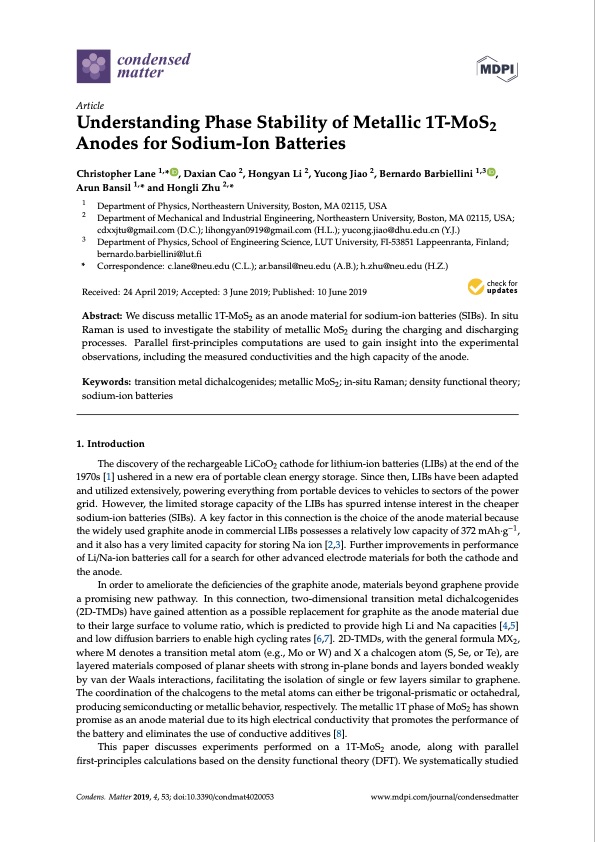
PDF Publication Title:
Text from PDF Page: 001
Article Understanding Phase Stability of Metallic 1T-MoS2 Anodes for Sodium-Ion Batteries Christopher Lane 1,* , Daxian Cao 2, Hongyan Li 2, Yucong Jiao 2, Bernardo Barbiellini 1,3 , Arun Bansil 1,* and Hongli Zhu 2,* 1 2 Department of Physics, Northeastern University, Boston, MA 02115, USA Department of Mechanical and Industrial Engineering, Northeastern University, Boston, MA 02115, USA; cdxxjtu@gmail.com (D.C.); lihongyan0919@gmail.com (H.L.); yucong.jiao@dhu.edu.cn (Y.J.) Department of Physics, School of Engineering Science, LUT University, FI-53851 Lappeenranta, Finland; bernardo.barbiellini@lut.fi 3 * Correspondence: c.lane@neu.edu (C.L.); ar.bansil@neu.edu (A.B.); h.zhu@neu.edu (H.Z.) Received: 24 April 2019; Accepted: 3 June 2019; Published: 10 June 2019 Abstract: We discuss metallic 1T-MoS2 as an anode material for sodium-ion batteries (SIBs). In situ Raman is used to investigate the stability of metallic MoS2 during the charging and discharging processes. Parallel first-principles computations are used to gain insight into the experimental observations, including the measured conductivities and the high capacity of the anode. Keywords: transition metal dichalcogenides; metallic MoS2; in-situ Raman; density functional theory; sodium-ion batteries 1. Introduction The discovery of the rechargeable LiCoO2 cathode for lithium-ion batteries (LIBs) at the end of the 1970s [1] ushered in a new era of portable clean energy storage. Since then, LIBs have been adapted and utilized extensively, powering everything from portable devices to vehicles to sectors of the power grid. However, the limited storage capacity of the LIBs has spurred intense interest in the cheaper sodium-ion batteries (SIBs). A key factor in this connection is the choice of the anode material because the widely used graphite anode in commercial LIBs possesses a relatively low capacity of 372 mAh·g−1, and it also has a very limited capacity for storing Na ion [2,3]. Further improvements in performance of Li/Na-ion batteries call for a search for other advanced electrode materials for both the cathode and the anode. In order to ameliorate the deficiencies of the graphite anode, materials beyond graphene provide a promising new pathway. In this connection, two-dimensional transition metal dichalcogenides (2D-TMDs) have gained attention as a possible replacement for graphite as the anode material due to their large surface to volume ratio, which is predicted to provide high Li and Na capacities [4,5] and low diffusion barriers to enable high cycling rates [6,7]. 2D-TMDs, with the general formula MX2, where M denotes a transition metal atom (e.g., Mo or W) and X a chalcogen atom (S, Se, or Te), are layered materials composed of planar sheets with strong in-plane bonds and layers bonded weakly by van der Waals interactions, facilitating the isolation of single or few layers similar to graphene. The coordination of the chalcogens to the metal atoms can either be trigonal-prismatic or octahedral, producing semiconducting or metallic behavior, respectively. The metallic 1T phase of MoS2 has shown promise as an anode material due to its high electrical conductivity that promotes the performance of the battery and eliminates the use of conductive additives [8]. This paper discusses experiments performed on a 1T-MoS2 anode, along with parallel first-principles calculations based on the density functional theory (DFT). We systematically studied Condens. Matter 2019, 4, 53; doi:10.3390/condmat4020053 www.mdpi.com/journal/condensedmatterPDF Image | Understanding Phase Stability of Metallic 1T-MoS2 Anodes for Sodium-Ion Batteries

PDF Search Title:
Understanding Phase Stability of Metallic 1T-MoS2 Anodes for Sodium-Ion BatteriesOriginal File Name Searched:
condensedmatter-04-00053.pdfDIY PDF Search: Google It | Yahoo | Bing
Sulfur Deposition on Carbon Nanofibers using Supercritical CO2 Sulfur Deposition on Carbon Nanofibers using Supercritical CO2. Gamma sulfur also known as mother of pearl sulfur and nacreous sulfur... More Info
CO2 Organic Rankine Cycle Experimenter Platform The supercritical CO2 phase change system is both a heat pump and organic rankine cycle which can be used for those purposes and as a supercritical extractor for advanced subcritical and supercritical extraction technology. Uses include producing nanoparticles, precious metal CO2 extraction, lithium battery recycling, and other applications... More Info
| CONTACT TEL: 608-238-6001 Email: greg@infinityturbine.com | RSS | AMP |